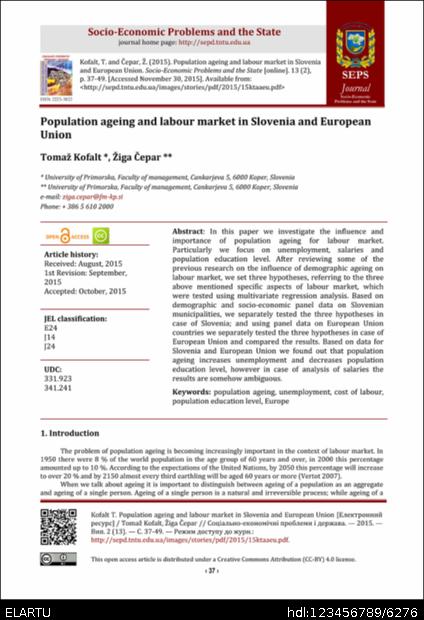Link lub cytat.
http://elartu.tntu.edu.ua/handle/123456789/6276

| Tytuł: | Population ageing and labour market in Slovenia and European Union |
| Authors: | Kofalt, Tomaž Čepar, Žiga |
| Akcesoria: | University of Primorska, Faculty of management, Cankarjeva 5, 6000 Koper, Slovenia University of Primorska, Faculty of management, Cankarjeva 5, 6000 Koper, Slovenia, e-mail: ziga.cepar@fm-kp.si, Phone: + 386 5 610 2000 |
| Cytat: | Kofalt T. Population ageing and labour market in Slovenia and European Union [Електронний ресурс] / Tomaž Kofalt, Žiga Čepar // Соціально-економічні проблеми і держава. — 2015. — Вип. 2 (13). — С. 37-49. — Режим доступу до журн.: http://sepd.tntu.edu.ua/images/stories/pdf/2015/15ktaaeu.pdf. |
| Bibliographic description: | Kofalt, T. and Čepar, Ž. (2015). Population ageing and labour market in Slovenia and European Union. Socio-Economic Problems and the State [online]. 13 (2), p. 37-49. [Accessed November 30, 2015]. Available from: <http://sepd.tntu.edu.ua/images/stories/pdf/2015/15ktaaeu.pdf> |
| Część publikacji: | Соціально-економічні проблеми і держава Socio-Economic Problems and the State |
| Data wydania: | 24-lis-2015 |
| Data archiwizacji: | sie-2015 |
| Date of entry: | 2-gru-2015 |
| Wydawca: | АСУ, ТНТУ ASU, TNTU |
| Place edycja: | Тернопіль Ternopil |
| UDC: | 331.923 341.241 |
| JEL: | E24 J14 J24 |
| Słowa kluczowe: | population ageing unemployment cost of labour population education level Europe |
| Zakres stron: | 37-49 |
| Abstract: | In this paper we investigate the influence and importance of population ageing for labour market. Particularly we focus on unemployment, salaries and population education level. After reviewing some of the previous research on the influence of demographic ageing on labour market, we set three hypotheses, referring to the three above mentioned specific aspects of labour market, which were tested using multivariate regression analysis. Based on demographic and socio-economic panel data on Slovenian municipalities, we separately tested the three hypotheses in case of Slovenia; and using panel data on European Union countries we separately tested the three hypotheses in case of European Union and compared the results. Based on data for Slovenia and European Union we found out that population ageing increases unemployment and decreases population education level, however in case of analysis of salaries the results are somehow ambiguous. |
| URI: | http://elartu.tntu.edu.ua/handle/123456789/6276 |
| ISSN: | 2223-3822 |
| Właściciel praw autorskich: | © Соціально-економічні проблеми і держава, 2015 |
| Związane URL literatura: | http://journals.plos.org/plosone/article?id=10.1371/journal.pone.0108501 http://www.eurofound.europa.eu/pubdocs/2007/0516/en/1/ef070516en.pdf http://www.stat.si/novica_prikazi.aspx?id=1180 |
| References: | Auer P, Fortuny M (2000) Ageing of the labour force in OECD countries: economic and social consequences. Geneva: International Labour Office. Bratić V, Vukšić G (2014) Fixed-term employment during transition: the Croatian experience. Eastern European economics 52(6):57–76. Campbell N (1999) The decline of employment among older people in Britain. Centre for Analysis of Social Exclusion Paper, No.19. London: London School of Economics. Caron G, Costello D, Guardia N, Mourre G, Przywara B, Salomaki A (2005) The economic impact of ageing populations in the EU25 member states. Brussels: European Commission. Čepar Ž, Bojnec Š (2008) Population aging and the education market in Slovenia and Croatia. Eastern European economics 46(3):68–86. (DfEE) Department for Education and Employment (2000) Factors affecting retirement: book 2 United Kingdom. DfEE research Report no. 236. Disney R, (1996) Can we afford to grow older? A perspective on the economics of aging. Cambridge, MA: MIT Press. Disney R (1999) Why have older men stopped working? In: Gregg P, Wadsworth J (eds) The state of working Britain. University Press, Manchester, pp 58–74. Disney R, Grundy E, Johnson P (1997) The dynamics of retirement: analyses of the retirement surveys. Department of Social Security Research Report, No. 72. HMSO, London. Dixon S (2003) Implications of population ageing for the labour market. In: Flowers A (eds) Labour market trends. Organisation for Economic Co-operation and Development, London, pp. 67–76. Fallick B, Fleischman C, Pingle J (2010) The effect of population aging on the aggregate labor market. In: Abraham KG, Spletzer JR, Harper M (eds.), Labor in the New Economy. University of Chicago Press, pp. 377–417. Johnson P, Zimmerman K (1993) Ageing and the European labour market: public policy issues. In: Johnson P, Zimmermann K (eds), Labour markets in an ageing Europe. Cambridge University Press, Cambridge, pp. 5. Kluge F, Zagheni E, Loichinger E, Vogt T (2014) The advantages of demographic change after the wave: fewer and older, but healthier, greener, and more productive? PLoS ONE 9 (9): e108501. http://journals.plos.org/plosone/article?id=10.1371/journal.pone.0108501. Accessed 17 April 2015. Malačič J (2003) Demografija - teorija, analiza, metode in modeli 5. izd. [Demography - theory, analysis, methods and models 5th ed.]. Faculy of Economics, Ljubljana. Miles D (2005) Modelling the impact of demographic change upon the economy. The Economic Journal, 109(452):1-36. Munnell AH (2014) The impact of aging baby boomers on labor force participation. Center for Retirement Research at Boston College, Boston. Samorodov A (1999) Ageing and labour markets for older workers. International Labour Office, Geneva. Serban AC (2012) Aging population and effects on labour market. Procedia Economics and Finance 2012 (1):356–364. Skirbekk V (2003) Age and individual productivity: a literature survey. MPIDR Working Paper WP 2003–028. Thießen U (2007) Aging and structural change. In Discussion Papers no. 742. German Institute for Economic Research, Berlin. Vagans A (2007) Employment and labour market policies for an ageing workforce and initiatives at the workplace - national overview report: Latvia. http://www.eurofound.europa.eu/pubdocs/2007/0516/en/1/ef070516en.pdf. Accessed 10 July 2014. Vertot N (2007) 1. oktober – mednarodni dan starejših [1st October - international day of elder people]. http://www.stat.si/novica_prikazi.aspx?id=1180. Accessed 1 July 2014. Vodopivec M (2014) Equal pay for equal work? Wage and productivity differentials during Slovenia’s transition. Eastern European economics 52(5):87–110. |
| Typ zawartości: | Article |
| Występuje w kolekcjach: | Журнал „Соціально-економічні проблеми і держава“, 2015, Випуск 2(13) |
Pliki tej pozycji:
| Plik | Opis | Wielkość | Format | |
|---|---|---|---|---|
| 15ktaaeu.pdf | 922 kB | Adobe PDF | Przeglądanie/Otwarcie | |
| 15ktaaeu.djvu | 472,34 kB | DjVu | Przeglądanie/Otwarcie | |
| 15ktaaeu__COVER.png | 400,84 kB | image/png | Przeglądanie/Otwarcie |
Pozycje DSpace są chronione prawami autorskimi